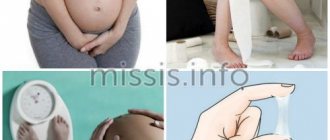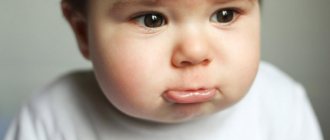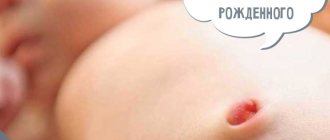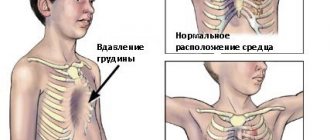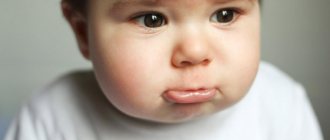Bronchial asthma in children
Authors : Tatochenko V.K.
How does asthma develop?
Asthma is defined by doctors as a disease characterized by episodes of bronchial obstruction (bronchial obstruction), which are fully or partially reversible. It is based on inflammation of the bronchial mucosa and bronchial hyperreactivity.
During an attack of bronchial obstruction, the lumen of both small and larger bronchi narrows.
All patients with asthma, when there is no attack, nevertheless show signs of an inflammatory process in the bronchial mucosa. This fact raises the question of treating the inflammatory process - and not only during an asthma attack. Such drugs exist, so persistent long-term treatment should be the basis of the fight against asthma.
No less important is the second point - about the presence in patients with asthma of bronchial hyperreactivity, that is, increased irritability of the bronchi, responding with spasm even to insignificant amounts of irritating substances in the inhaled air. This forces us to create a healthy air environment for these patients.
“Not everything will outgrow,” so bronchial obstruction will stop after 1-2 such episodes. It is this fact that gives rise to difficulties in the above-mentioned “relationships” with a diagnosis of “aspsychic asthma.” A normal attack develops suddenly, breathing quickens, exhalation becomes difficult, the child takes a sitting position and breathes shallowly. Often wheezing can be heard from a distance, sometimes it is felt only when the child's ear is raised to the child's mouth. Difficulty in exhaling leads to air retention in the chest; it usually swells; if you put your hands on it, you feel a trembling at the exit.
An attack can last from several minutes to many hours, and often ends spontaneously. However, waiting for it to pass or using dubious means (there are a lot of them) is unacceptable: suffocation is a very painful phenomenon, so every minute of delay in effective treatment increases the child’s suffering and frightens him, which in itself can intensify bronchospasm. In more severe cases, intensive care is required.
Patients also differ in the nature of the interictal period. In some patients, no changes can be detected, while in others, even in the interictal period, there are significant restrictions on the respiratory function.
Asthma treatment
When I look at a child with asthma, the first thing I inform his parents is that asthma cannot be cured by any known remedy. This may be cruel, but why am I talking about this? Because many parents, in search of a miracle cure, try a variety of methods, most of which not only do not bring benefit, but also harm the patient.
If you don’t expect a cure, then what is the point of treatment? Its meaning is to reduce the severity of asthma, learn to prevent attacks, at least make them less frequent, and quickly relieve an attack if it occurs. In short, to make a child’s life as fulfilling as a healthy child’s.
And regarding the possibility of a cure, I always “lighten the soul” of parents - in a very large percentage of cases, a child’s asthma goes away on its own.
Well, how to properly treat asthma? It is necessary to clearly distinguish between therapeutic measures that help get rid of an attack that has already occurred, and means that mitigate the course of the disease.
How to prevent an attack? Seizure prevention is the main goal of basic treatment. But to this we should also add measures to possibly prevent contact with allergens, primarily with house dust. It is better to remove carpets and upholstered furniture, at least in the room where the child sleeps. I often joke that the ideal bedroom for a child is a prison cell, where there is nothing but a bed, a table and a stool. It is important to close books in glass shelves, use a vacuum cleaner for cleaning more often, and preferably a moisturizing one. To reduce the patient’s contact with the dermatophagoides mite, you should cover the child’s mattress with plastic wrap and put 2 pillowcases on the pillows. Taking into account the allergenic properties of bird feathers, feather pillows should be replaced with cotton wool or foam rubber.
It is very difficult to part with pets, but it is necessary if a child is sensitive to their fur. You should not have fresh flowers in the room - not only their smells and pollen can be dangerous for the patient, but also the aspergillus fungus, which often grows in flower pots. In young patients with asthma, an attack can often be associated with food allergens.
There is hardly any need to talk about the dangers of smoking in an apartment where there is an asthma patient. For him, first of all, conditions should be created that ensure maximum stay in the fresh air. And all other allergy prevention measures must be fully observed.
It is very important to harden the child - this will reduce the incidence of respiratory infections, which often cause an attack and contribute to increased bronchial hyperreactivity.
Many children with asthma do not tolerate physical activity well - after 5-7 minutes from the start of running or outdoor games, they experience bronchospasm, causing shortness of breath, or even an asthma attack. To prevent this, you should take 1-2 inhalations of a beta-myetic or take aminophylline powder, after which bronchospasm will not develop, and after 20-30 minutes, under the influence of physical activity, the bronchi, on the contrary, will expand, which is very useful for the patient.
That is why physical education and increasing physical endurance are included in the arsenal of therapeutic agents for asthma. Moreover, physical training increases the patient’s self-esteem, helps him develop self-confidence and reduces dependence on adults. Breathing exercises are very useful; asthma patients learn proper breathing during exercise.
Many parents ask whether a child with asthma can go south to the sea. Experience shows that such climate change usually provokes an asthma attack, so you need to be prepared for this. But then children usually feel good and get a lot of benefits from being at sea - after all, the sea air is very clean, breathing it reduces bronchial hyperreactivity. Upon returning home, many patients experience asthma attacks again, and one must also be prepared for this. In general, the benefits of such a trip will be noticeable if you stay in the south for a month and a half or two, no less.
Another common question is about climate change. In most cases, it is not possible to “choose” the climate, so I usually do not advise parents to embark on this very difficult undertaking. If asthma is clearly associated with the flowering of a particular plant, it is sometimes possible to take the child to another region for this period, but most often it is not possible to completely get rid of asthma in this way. The same applies to trips to the mountains, where at an altitude of 1500-2000 meters there are very few allergens: this is useful (including from the point of view of physical training), but it is still not possible to completely get rid of asthma.
Well, how should you feel about treating asthma in salt mines? There are no allergens in the air, and this helps reduce bronchial hyperreactivity. But you can’t spend your whole life in a mine, so you can’t count on a cure. But staying in a halochamber (a room whose walls are covered with salt) seems to me at least doubtful.
Alternative Treatments
Many people have heard or read about miracle cures - acupuncture, special breathing techniques, miracle drugs, psychics who supposedly cure asthma. Yes, indeed, a mild attack can be relieved by holding your breath or acupuncture, but I could never understand why acupuncture is better than inhalation. Moreover, holding your breath even with moderate asthma can be very dangerous.
I don’t know of a single solid study that would prove the cure of asthma using these methods, and information like “we were treated by a psychic and the asthma went away” is completely unconvincing: after all, in most children, asthma goes away sooner or later!
But the harm from all these methods is the same - by resorting to them, parents are distracted from those measures that really help with asthma, in particular, they do not carry out basic treatment. And the use of other medications during an attack (you hear from parents that they were recommended broncholitin, no-shpu, papaverine, solutan and even antibiotics) is unacceptable, since they, as a rule, do not alleviate the child’s suffering.
What does the future hold for an asthma patient? With proper treatment, as a rule, it is possible to stabilize the child’s condition, and if the attacks do not stop completely, then their frequency and severity decreases.
And we must not forget that very often asthma goes away.
published 09/15/2011 21:15 updated 07/30/2018 — Respiratory diseases
A reminder for parents on providing first aid to a child in the event of an asthma attack
Dear parents!
Proper first aid can relieve an attack and, in some cases, save your child’s life.
The procedure for providing first aid in the event of an attack of bronchial asthma:
- Provide access to fresh air (if there is no allergy to pollen), calm the child, give a hot drink. If possible, stop contact with allergens, if an attack is provoked by an acute respiratory viral infection - drip vasoconstrictor drops into the nose (naphthyzin, galazolin, nazol, xymelin, vibrocil, nazivin).
- Inhale, strictly following the technique, one or two doses of a bronchospasmolytic (Berotec or Salbutamol or Ventolin or Berodual) through a spacer. If you have a nebulizer at home, treat an attack by inhaling a special solution of Berodual, 1 drop per kilogram of the child’s weight, but no more than 10 drops for young children and no more than 20 drops for children over 6 years old. Frequency of bronchodilator inhalations as needed, but not more than 4 inhalations per day. If necessary, add nebulization of pulmicort (250-500 mcg 2 times a day).
- If the effect is positive, continue inhalation of the bronchospasmolytic for 4-6 hours for 1-2 days. Do not stop treatment with basic drugs (Intal, Tailed, Beclazone, Flixodite, Seredit, Symbicort). The bronchospasmolytic is inhaled 30 minutes before taking the basic drugs. Within 1-2 days after the attack, you must visit your doctor to adjust the basic therapy. Before visiting a doctor, you need to increase the dose of the basic (preventive) drug by 2 times. If a child receives basic therapy with Singulair, the dose of the drug remains the same.
- If the attack does not stop immediately call an emergency doctor and repeat the inhalation of the bronchospasmolytic after 20 minutes, you can inhale 1-2 doses of Atrovent if you used salbutamol, Berotec, or Ventolin. After achieving a positive effect, go to P.Z.
- If there is no effect from the measures taken, after 20 minutes, inhale 2 more doses of the bronchospasmodic and calmly wait for the emergency doctor.
- Drugs and methods that SHOULD NOT be used during an attack of bronchial asthma: sedatives, herbal decoctions, mustard plasters, cups, calcium supplements, magnesium sulfate, antibiotics. Basic therapy drugs are not effective in relieving suffocation that has already occurred.
DEAR PARENTS, emergency medications should always be in your first aid kit! If the need for them becomes daily or almost daily, consult a doctor!
Bronchial asthma: characteristics of an attack depending on the age of the child
Dear mothers, of course, you are not doctors and you cannot know everything, and you are not obliged to. However, it will be better if you “arm yourself” with some knowledge about the symptoms of an asthma attack depending on the age of the child. This is necessary so that you can provide timely assistance to your baby.
Bronchial asthma sometimes debuts even in the first months of life
.
However, unfortunately, the diagnosis is often made later.
Because doctors mistake the baby’s difficulty breathing and wet cough as a manifestation of an acute viral infection or acute obstructive bronchitis.
The reason is the atypical course of the disease in children in the first few years of life. This is due to some structural features of the lung tissue (small volume) and the bronchial tree (narrow lumen of the bronchi, easily wounded mucous membrane, good blood supply).
All these points lead to the development of pronounced swelling and narrowing of the bronchi (spasm), as well as the release of a large amount of mucus into their lumen. As a result, the patency of the bronchi is impaired. Therefore, a large number of moist rales are heard in the baby’s lungs.
However, you should think about bronchial asthma if:
• the baby has repeated episodes of severe painful cough, and the interval between them is less than eight days
• for three days, the child experiences nocturnal attacks of severe, painful cough.

